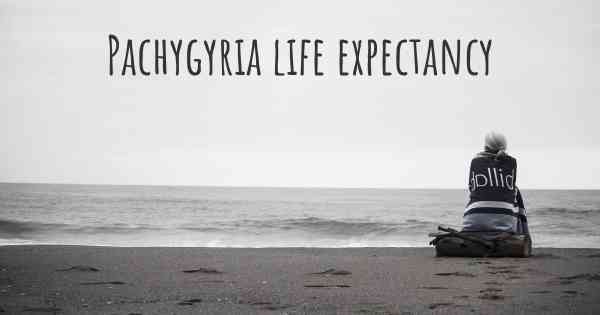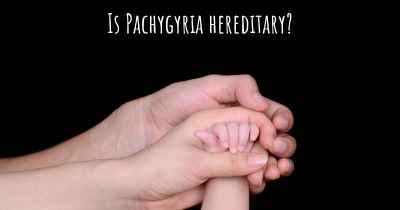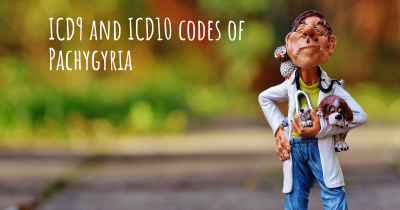What is the life expectancy of someone with Pachygyria?
Life expectancy of people with Pachygyria and recent progresses and researches in Pachygyria

Pachygyria is a rare neurological condition characterized by abnormal brain development, resulting in a thickened cerebral cortex with fewer and broader folds. The life expectancy of individuals with pachygyria can vary significantly depending on the severity of the condition and associated complications. While it is challenging to provide an exact prognosis, it is important to note that pachygyria is typically associated with developmental delays, intellectual disabilities, and various neurological symptoms.
Early intervention, appropriate medical care, and supportive therapies can significantly improve the quality of life for individuals with pachygyria. However, it is crucial to consult with healthcare professionals who can provide personalized information and guidance based on the specific case.
Pachygyria is a rare neurological disorder characterized by abnormal brain development, specifically in the cerebral cortex. It is a type of lissencephaly, which means "smooth brain," as the usual folds and grooves of the brain are significantly reduced or absent in individuals with this condition. Pachygyria can result in various cognitive, motor, and developmental impairments, and the severity of symptoms can vary widely among affected individuals.
Due to the complexity and heterogeneity of pachygyria, it is challenging to provide a definitive life expectancy for individuals with this condition. The prognosis depends on several factors, including the underlying cause, the extent of brain malformation, associated medical conditions, and the availability and effectiveness of supportive care and treatments.
Causes and Types of Pachygyria:
Pachygyria can be caused by genetic mutations or occur sporadically without a known cause. Some genetic mutations associated with pachygyria include those affecting the LIS1, DCX, TUBA1A, and RELN genes. These genes play crucial roles in brain development and neuronal migration.
There are different types of pachygyria, classified based on the severity and extent of brain malformation. These include:
- Focal Pachygyria: In this type, only specific regions of the brain have abnormal thickening, while other areas develop normally.
- Generalized Pachygyria: This form involves more widespread thickening of the cerebral cortex, affecting larger areas of the brain.
- Frontal Pachygyria: The frontal lobes of the brain are primarily affected in this type, leading to specific cognitive and behavioral challenges.
- Occipital Pachygyria: Occipital lobe involvement can result in visual impairments and other associated symptoms.
Impact on Life Expectancy:
As mentioned earlier, predicting the life expectancy of individuals with pachygyria is difficult due to the wide range of symptoms and associated complications. Some individuals may have milder forms of pachygyria and experience relatively normal lifespans, while others with severe forms may face significant challenges and have a reduced life expectancy.
Common complications and health issues associated with pachygyria that can impact life expectancy include:
- Seizures: Epileptic seizures are a common feature of pachygyria and can vary in frequency and severity. Uncontrolled seizures can lead to accidents, injuries, and other complications.
- Intellectual and Developmental Disabilities: Pachygyria often results in cognitive impairments, developmental delays, and learning difficulties. These challenges can impact an individual's ability to lead an independent life and may require ongoing support and care.
- Motor Impairments: Many individuals with pachygyria experience difficulties with motor skills, including muscle weakness, poor coordination, and balance problems. These impairments can affect mobility and increase the risk of accidents and injuries.
- Respiratory Issues: In some cases, pachygyria can affect the muscles involved in breathing, leading to respiratory problems and an increased susceptibility to respiratory infections.
- Feeding and Swallowing Difficulties: Pachygyria can impact the muscles involved in swallowing, leading to feeding difficulties and an increased risk of aspiration pneumonia.
- Other Medical Conditions: Individuals with pachygyria may have additional medical conditions or abnormalities, such as heart defects, gastrointestinal issues, or vision and hearing impairments. The presence of these conditions can further impact life expectancy.
Supportive Care and Management:
While there is no cure for pachygyria, supportive care and management strategies can significantly improve the quality of life for affected individuals. This may include:
- Seizure Management: Antiepileptic medications and other seizure management techniques can help control and reduce the frequency of seizures.
- Physical and Occupational Therapy: Rehabilitation therapies can assist in improving motor skills, enhancing mobility, and promoting independence.
- Speech and Language Therapy: Speech therapy can help individuals with pachygyria overcome communication difficulties and improve their ability to express themselves.
- Education and Specialized Support: Tailored educational programs, individualized support, and assistive technologies can aid in maximizing learning potential and overall development.
- Monitoring and Treatment of Associated Conditions: Regular medical check-ups, early intervention, and appropriate treatment of associated medical conditions can help manage complications and improve overall health.
Conclusion:
Pachygyria is a complex neurological disorder with varying degrees of severity and associated complications. It is challenging to provide a specific life expectancy for individuals with this condition due to the wide range of factors involved. The prognosis depends on the underlying cause, the extent of brain malformation, associated medical conditions, and the availability of supportive care and treatments. Early diagnosis, comprehensive medical care, and appropriate interventions can greatly enhance the quality of life for individuals with pachygyria and potentially extend their lifespan.








